Denis Valentinovich Manturov Minister of Industry and Trade of the Russian ...


Greetings, dear plant lovers.
Everyone knows what negatively affects the growth and development of plants, which naturally affects the quantity and quality. harvested... Today I will tell you about how our most common favorite vegetables react to the lack of basic nutrients - nitrogen, phosphorus, potassium. And also about what to do if you are outward signs identified the lack of one or another element.
It manifests itself most strongly in the presence of high soil moisture, especially when it rains for a long time, as well as during drought or prolonged cold weather.
With a lack of nitrogen, the leaves of plants become small, pale green in color with a yellowish tinge, and the fruits are crushed and, as a rule, fall off ahead of schedule.
Consider the specific reaction of a particular vegetable plant to a lack of nitrogen:
Carrots are small leaves, grow very slowly, turn yellow and die off.
Onions - grows poorly, narrow short leaves of a light green color, often begin to blush from the tip of the leaf.
Cabbage - stunted in growth, becomes dwarf, small leaves, at first pale green with a yellowish tinge, and later turn orange, dry quickly and soon fall off.
Beetroot - withers, stunted, has erect, thin leaf stalks. The color of the leaves is from pale green to yellow-red.
Tomatoes - overall growth is strongly suppressed. Small leaves turn light green with a purple or yellow tint along the veins. Old leaves die off very quickly. The stems are tough and slender. The roots darken and soon die off. Tomatoes with a lack of nitrogen have woody, small fruits, which at first have a pale green color, then turn bright red and often fall off prematurely.
Cucumbers - lagging behind in growth, have pale green leaves with a yellow tinge of small size. Especially quickly the lower leaves droop and turn yellow. Stems are fibrous, thin, more rigid, with a pale color. Cucumbers develop very, very slowly with a lack of nitrogen.
What should a gardener do if he noticed signs of a lack of nitrogen in the soil?
The circuit is very simple. It is urgent to feed the plants with a urea solution. For this, 1 tablespoon of urea is diluted in 10 liters of water. The consumption of this solution is 3 liters per 1 square meter.
Plants need phosphorus to increase the regenerative (restorative) properties of tissues, to accelerate their development. Plants suffer most from phosphorus deficiencies in hot and dry weather when the soil temperature is elevated. At the same time, the growth of the stem slows down, purple or reddish stripes or spots appear on the leaves. Roots and shoots develop slowly, poorly, and, therefore, the formation of roots, heads of cabbage, fruits slows down.
Carrots - the leaves become reddish, the whole plant is stunted, dwarf roots are formed.
Onions - tips fade on old leaves, after which they turn black and soon die off completely.
Cabbage - the growth of young leaves is slowed down. A clear sign= dark green color of young leaves.
Tomatoes - plants have a depressed look. The leaves turn dark green on the upper side, and their color turns purple-lilac from the bottom. This is especially noticeable when grown. The flowering of tomatoes and the ripening of their fruits with a lack of phosphorus is noticeably delayed.
Cucumbers - young leaves at first turn dark green, then begin to shrink, wrinkle, their edges begin to curl upward. At the same time, the plant significantly lags behind in growth, flowering and fruit formation is also delayed.
What should be done when the first signs of phosphorus deficiency are detected?
It is necessary to add superphosphate to the soil (1 square meter - 1 tablespoon), or phosphorous flour (1 square meter - 2 tablespoons), or any other fertilizers containing phosphorus. It should also be noted here that the early liming of soils with an acid reaction improves the phosphorus nutrition of plants.
The main tasks of potassium in soil nutrition of plants are: ensuring normal photosynthesis, increasing plant resistance to various infectious diseases... In the phase of intensive growth, plants especially need potassium.
Potassium is especially necessary for vegetables on light soils, as well as in dry weather. A lack of potassium can occur in the soil when magnesium and calcium are too much added to it. When liming acidic soils, the need for fertilizers containing potassium always increases.
With a deficiency of potassium, the growth of vegetable crops is inhibited, the stems and shoots are poorly developed, often bent, their tops dry out. The leaves acquire a dark green color, but already with a bronze or bluish tint. On the leaves, you can see the places of tissue death. The edges of the leaves first turn yellow and then dry out.
Carrots - the whole plant becomes stunted, the leaves are pale colored, later they acquire a bronze tint, slightly curl. The tips of the leaves turn brown and dry out. Gradually, such leaves completely die off, and in general, the aerial parts of the plant develop strongly, to the detriment of the carrot root crop.
Onions - starting from the tip, old leaves turn grayish and straw yellow, after which the leaf turns completely yellow and soon withers. If you do not take appropriate measures, there will be a complete early drying of the leaves.
Beets - lagging behind in growth, the leaves, instead of the proper green color, acquire a dark crimson color.
Cabbage - you can see a sudden yellowing of the border of the lower and sometimes the middle leaves of the plant. Then this yellowing spreads to the entire leaf, but the color of the veins remains green. Further, the number of yellowed leaves increases rather quickly, from the bottom up. The lowermost leaves turn brown, start drooping, and eventually dry out.
Tomatoes - begin to lag significantly in growth, shoots and stems are poorly developed, often bent and become woody. The color of the leaves of tomatoes with a lack of potassium is bluish-green, and in older leaves it is yellowish at the edges or pale gray. Later, the edges of old leaves curl upward and become as if burnt. Tomato ovaries often fall off, non-simultaneous ripening of fruits is observed. The roots are very poorly developed, often brown in color.
Cucumbers - plant growth slows down, the leaves become small, domed, dark green in color. A distinctive feature is the appearance of a light yellow border on the leaves. The fruits become pear-like - narrowed at the stalk and widened towards the top.
What to do if there are signs of potassium deficiency in the soil?
It is necessary to feed the plants with sulfuric acid potassium (for 1 square meter of beds - 7 - 10 grams of the drug), or potassium magnesia (for 1 square meter of beds - 15 - 20 grams of the drug), you can also use ordinary wood ash (for 1 square meter - 100g).
That's all for today. Take a closer look at your green pets and then you can feed them in time to prevent flaw nutrients in the soil and get a wonderful harvest.
See you, dear friends!
Roses are especially sensitive to a lack of nitrogen in spring, so they need to be fed with ammonium nitrate, urea or any complex fertilizer containing nitrogen (1 tablespoon per 10 liters of water). For top dressing, you can use any organic fertilizers in appropriate proportions.
EXCESS
The foliage becomes dark green, the plants grow violently, the stems are soft, few flowers are formed, they are easily affected by fungal diseases. In these cases, it is necessary to exclude nitrogen from the diet and feed the plants with phosphorus-potassium fertilizers.
PHOSPHORUS
FLAW
 |
EXCESS
Excess phosphorus leads to soil salinization and manganese deficiency. Metabolism is disturbed. The plant does not assimilate iron and copper.
POTASSIUM
FLAW
With a deficiency of potassium, the edges of the leaves turn yellow, the veins remain green. Often the edges of the leaves dry out. Gradually, the leaves turn yellow completely and acquire a reddish-purple color. Yellowing begins at the top of the leaves. The flowers are small. Young leaves turn reddish with brown edges. Often seen in roses growing on sandy soils. The withering process starts from the lower leaves and spreads to young leaves. They turn black, and the stems of roses die off. Usually, there is not enough potassium for roses on sandy and peaty soils. With a lack of potassium, roses must be fed with potassium fertilizers - potassium sulfate, potassium magnesium or complex fertilizer (1 tablespoon per 10 liters of water).
EXCESS
Delayed development. You should stop feeding with potash or complex fertilizers.
CALCIUM
FLAW
It occurs with an excess of potassium. Calcium occurs naturally in the form of limestone, chalk and other compounds. It is necessary for plants for the normal development of the aerial part and the growth of roots. With a lack of calcium, the stems and leaves are weakened, the tops of young leaves are sick or die off, the peduncles die off, the roots do not develop. Young leaves are crocheted. In this case, the plants need to be fed with superphosphate or calcium nitrate (1 tablespoon per 10 liters of water).
IRON
FLAW
Plants experience iron deficiency very often on neutral, alkaline and calcium-rich soils. Leaves turn yellow starting from the edges. Young leaves are especially affected. A narrow green strip remains around the veins. If chlorosis progresses, small veins also become discolored. The leaf becomes almost white or cream-white in color, then the leaf tissues die off and they fall off. If there is a lack of iron, it is necessary to add rapidly decomposing organic fertilizers or any acidifying fertilizer to the soil, two-three times to carry out top dressing with iron-containing preparations (complex fertilizer "Kemira Universal 2" - 1 tablespoon per 10 liters of water).
MAGNESIUM
FLAW
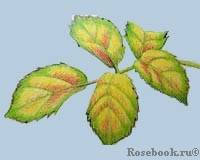 |
SULFUR
FLAW
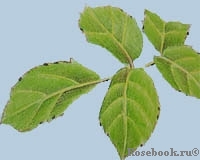 |
MANGANESE
FLAW
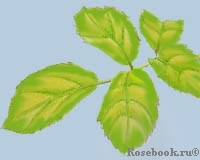 |
FLAW
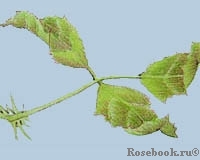 |
COPPER
FLAW
Chlorotic spots spread along the entire edge of the leaf. The green color is preserved only along the veins. Often dead areas appear on the leaf - along the edges and between the veins.
MOLYBDENUM
FLAW
Buds and flowers fall.
Based on the materials of the books "Roses" / Theorina A.I. - M .: JSC "Fiton +", 2007 and Ortho "s Complete Guide to Roses / Meredith Books 2003.
Let's continue our acquaintance with leaves. In the previous article, we learned how plants behave when there is a lack of basic nutrients. In this article, you can learn how to determine the lack of elements such as iron and magnesium by the leaves. Having familiarized yourself with the main signs of a lack of one or another element, you can easily correct the situation and get crops on any soil.
The lack of such a trace element as iron, we have more than once been able to observe in our garden, this yellowing or paleness of the upper leaves, and this is called chlorosis... Plants that need an acidic soil reaction, such as hydrangea, blueberries, rhododendrons, azaleas, and everyone's favorite petunias, are especially susceptible to chlorosis. But other plants can be iron deficient as well.
Often chlorosis occurs on calcareous soils... Iron, even if it is abundant in calcareous soil, cannot be absorbed by plants, because it is in a form inaccessible to them. Chlorosis can also be caused by a lack of nutrition, too dry or too wet soil, frost, various viral diseases, an excess of trace elements such as copper, zinc, manganese.
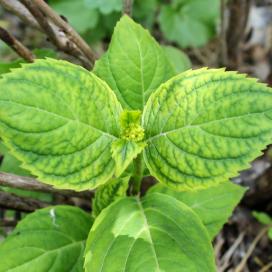
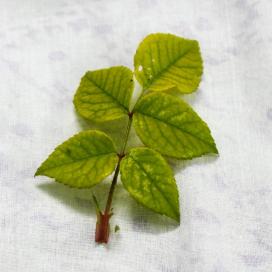
When chlorosis is just beginning to develop, the leaves of plants acquire a yellowish tint, and the network of veins is still green. With severe chlorosis, the leaves brighten even more, become almost white, the veins of the leaf also brighten (not to be confused with variegated forms of plants, in which the leaves must by definition be yellow or white). The edges of the leaves begin to die off, the tips turn brown.
Chlorosis begins to manifest itself first on young, and then on old leaves. Sometimes, with a lack of iron, young shoots or tree tops dry up. Sometimes chlorosis can be confused with other plant diseases, for example, tomato ring spot virus.
Since chlorosis most often occurs on alkaline (calcareous) soils, it is necessary to apply fertilizers to the soil that acidify the soil, and thus iron becomes available and absorbed from the soil by plants: ammonia nitrogen - ammonium salts, nitrate nitrogen - potassium, calcium or sodium nitrate... The soil can be acidified with a weak solution of sulfuric acid (no more than 10 ml per 10 liters of water) or added to the soil colloidal sulfur... Do not forget to prepare such solutions only in plastic buckets.
To fix the situation, you can also use iron chelate... Such a chelated solution can be prepared even at home, for this you need boiled water, citric acid, iron vitriol.
Pour cooled boiled water into a three-liter jar. Dissolve about 12 grams of citric acid in this water and stir well until the acid crystals are completely dissolved, then add about 8 grams of ferrous sulfate to this solution. The result is a light orange "rusty" liquid that can be used to feed plants.
The lack of magnesium appears quite often on light sandy or sandy loam soils. All plants grow very poorly with a lack of magnesium.
Magnesium starvation in apple trees it looks like chlorosis (lack of iron). Likewise, the leaves begin to turn yellow, while the veins and leaf tissues next to them remain green. Then, necrosis (dying off) begins to form from the edge of the leaf, because of which the edges of the leaf begin to bend down, as if they gather, wrinkle, the leaves become domed. Gradually, the edges of the leaves become torn. Only in contrast to "iron" chlorosis, magnesium starvation is observed primarily on old leaves, and not on young ones.
In stone fruit crops, a lack of magnesium causes premature yellowing of the leaves, after which they can crumble ahead of time. In pears, due to a lack of magnesium, the leaves turn black. In black currant, the leaves also acquire a domed shape due to the fact that the edges of the leaves begin to bend downward.
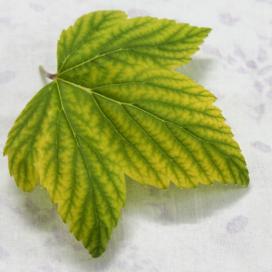
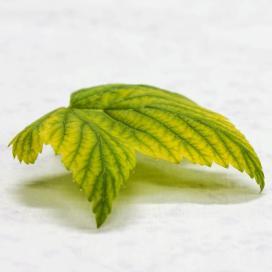
In garden strawberries or strawberries, magnesium deficiency can also be determined by discoloration of the leaves. The leaf tissue between the veins may turn yellow, redden or turn purple, violet, while the veins of the leaves remain green for a long time. With a very strong magnesium starvation, the leaves of the berries dry out prematurely.
In order to avoid magnesium starvation by plants on light soils, it is necessary to fertilize with fertilizers containing magnesium.
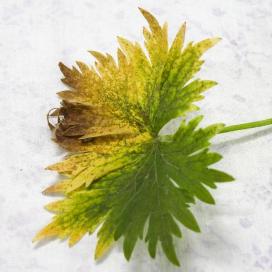
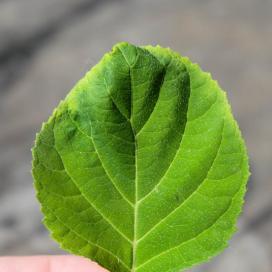
For example, potassium magnesium- very effective potassium-magnesium fertilizer, which contains 30% potassium and 15% magnesium. The fertilizer dissolves easily in water.
Dolomite flour, which contains calcium and magnesium, so dolomite flour can be used not only for liming the soil, but also as a magnesium fertilizer, it all depends on the application dose. If you use dolomite flour as a fertilizer, then you need to apply it in spring and autumn during the main soil cultivation in a small dose - no more than 20-30 g per sq. m, while for liming the soil, the dose of dolomite flour increases almost tenfold and depends on the acidity of the soil.
Magnesium sulfate, or magnesium sulfate (magnesium content - 16%) - this fertilizer is also effective both in root and foliar dressings.
So, we can draw a small conclusion: chlorosis (yellowing of a leaf with remaining green veins) on young leaves is caused by a lack of iron, chlorosis on the old lower leaves is a lack of magnesium.
Under natural conditions, each plant participates in the cycle of substances in nature. Earthworms, fungi, bacteria and insects living in the soil break down dead organisms into their constituent elements. This produces important minerals necessary for plant nutrition. They are absorbed by the plant through the roots and used as building blocks for new cells.When a plant dies, it is processed by insects and microorganisms living in the soil; the mineral compounds of which its tissues consisted are decomposed into constituent elements and become available to other living organisms.
Houseplants are excluded from this cycle of substances, and therefore they have to be content with only those minerals that we provide them with.
Since the volume of soil in a pot is not particularly large, it is quite common for plants to suffer from a lack or excess of nutrients.
Typically, nutrients, depending on the needs of the plant, are divided into micro and macro elements.
Most of all, the plant needs macronutrients: nitrogen, phosphorus and potassium, as well as sulfur, magnesium and calcium. Trace elements include boron, iron, copper, manganese, molybdenum, and zinc. Each element of mineral nutrition in a plant performs at least one, and sometimes several important functions. Trace elements are necessary for the plant in small quantities, but their lack negatively affects its viability.
The following is a list of essential nutrients and describes the functions they perform in the plant's body.
Nitrogen (N)
It is considered the most important for the plant, because it is the main constituent of plant protein compounds. Nitrogen is essential for the growth of leaves and shoots, and for the formation of green leaf cells (chlorophyll).
Phosphorus (P)
Phosphorus influences the growth of roots, buds and buds. In addition, it is necessary for the ripening and coloring of flowers, fruits and seeds.
Potassium (K)
This element is necessary primarily to maintain water balance plants because potassium helps to retain water in cells. In addition, potassium increases the resistance of plants to pests and the ability to withstand adverse conditions.
Sulfur (S)
Just like nitrogen, it is a building material for the formation of proteinaceous plant compounds and chlorophyll. The latter also applies to one more element - Magnesium (Mg).
Calcium (Ca) increases the strength of plant tissues and, like potassium, helps to increase plant endurance.
However, sometimes flower growers notice disturbances in growth or color in their pets and cannot find a reason for this. Although they cannot detect any pests, they may use some kind of special protective agent just in case.
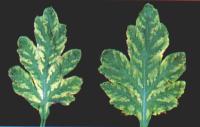 |
|
| This chrysanthemum suffers from a lack of magnesium. |
O lack of nitrogen can be recognized by the slowdown in growth: decorative-leaved plants form very few new shoots. The leaves turn pale, become light green, reddish tints are also possible. This is primarily manifested in older leaves, which fall prematurely at the next stage.
Excess nitrogen manifests itself in the dark green color of the leaves and the porous soft tissue of the plant. Disease and pest resistance decreases. If flowers do not form or are pale in color, then we are talking about lack of phosphorus... In this case, the lower, older leaves often turn dirty green, in addition, other colors may also be present in their color, from blue to red and purple. Young leaves remain small, and their tips are curved upward.
Plant suffering from lack of potassium becomes lethargic, especially on warm and sunny days. It remains small and squat, often the leaves turn pale at the edges and fall off. With a lack of potassium, the plant's resistance to various diseases and pests decreases.
A typical sign talking about lack of iron, is the so-called chlorosis of leaves: their veins become dark green, and the surface of the leaf between them turns pale and becomes yellowish. Plants especially often suffer from iron deficiency when daylight hours decrease or when the acidity level of the soil decreases.
In connection with the feeding of plants, it is also worth saying a few words about the level of soil acidity. The acidity level is understood as the ratio of acids to alkalis. For clarity, we will introduce a scale from 1 to 14. At an acidity level of 7, the soil is considered neutral. If the pH is less than 7, then the soil is acidic, if more, then alkaline.
The ability of plants to absorb nutrients depends on the level of soil acidity. They are best absorbed if the soil is slightly acidic or neutral (pH 5.5 to 7). If the pH value deviates in one direction or another, then the plant may show signs of a lack of nutrients, although they will be contained in the required amount in the soil.
The more lime is contained in the water for irrigation, the faster the soil acidity level decreases (the pH value increases). The leaves of the plant begin to turn yellow (lack of nitrogen) or chlorosis of the leaves (lack of iron) develops.
These signs are especially common in plants that prefer acidic soil. These include camellia (Camellia japonica), cattleya (Cattleya labiata) and azalea (Rhododendron simsii). These plants thrive best if the pH is 4 - 5. When growing them, you can use special ammonium containing mineral additives that increase the acidity of the soil or maintain it at the desired level. We mean oxidizing additives.
In addition, we also recall that irrigation water must be soft to prevent the accumulation of alkalis in the soil.
If you suspect that improper soil acidity is causing your plants to grow impaired, check the pH value with a pH tester available from your flower or garden store.
Plant nutrient requirements depend on a number of factors. It is especially high during the growth period, that is, from March to September.
Most plants during this period need to be fed at least once a week. The situation is different in winter, when each plant has its own feeding regime. Plants overwintering in a shaded or cool room are fed every three to four weeks. Plants that have a dormant period in winter stop feeding altogether. The requirement for various minerals varies greatly depending on the phase of plant development.
A young plant needs fertilizers with a high nitrogen content, which promotes the growth of stems and leaves. Later, during the flowering period, phosphorus-containing mineral supplements should be added.
Potassium in a sufficiently large amount is always necessary for a plant, regardless of the phase of development.
During the growing period, feeding should be started two to four weeks after purchase. If you planted the plant yourself, start feeding it only after the shoots appear. At the same time, you have a choice between mineral and organic fertilizers. When using mineral fertilizers, nutrients are available to plants immediately. With regard to organic fertilizers, the nutrients contained in them are absorbed by the plant more slowly.

The most common organic fertilizers are compost and manure. However, they are more suitable for a garden or flower bed than for indoor plants. Homemade compost cannot be measured for mineral content, and this can easily damage sensitive indoor plants due to improper feeding. Other organic fertilizers such as horn shavings, bone meal, blood meal, and guano are best added to the soil when transplanting.
In specialized stores, you can buy organic fertilizers, which also contain microorganisms that have a beneficial effect on the composition of the soil and prevent excessive evaporation of water and the formation of a crust on the soil surface.
The easiest way to feed indoor plants is to use mineral fertilizers, because in this case, the plant can receive all the important nutrients in the right proportion.
Liquid mineral fertilizers
This is the most common way to feed plants. In this case, a concentrated nutrient solution is used, containing all the necessary micro- and macroelements. There are special mixtures with a high nitrogen content - for decorative leaf plants. In contrast, mixtures with a high phosphorus content are used for decorative flowering plants.
The application method for this type of fertilizer is quite simple. The fertilizer concentration should not be higher than that recommended on the package, even if your plants show symptoms that indicate a lack of nutrients. Too high a fertilizer concentration can damage delicate roots.
Soluble mineral fertilizers in the form of salt
They contain all the substances the plant needs, including magnesium. The appropriate amount of fertilizer is dissolved in water. Usually only a very small amount of salt is required, it is best to measure it with a scale.Pills and sticks
This feeding method is easier, but less accurate than those described above. Depending on the size of the pot and plant, a certain number of nutrient sticks or tablets are injected into the soil.
The plant assimilates the minerals contained in them gradually, and the risk of oversaturation is reduced.
Special fertilizers
Some plant species, such as cacti, bromeliads or orchids, have their own specific nutritional requirements. Special nutritional mixes are available for these plants.
Plants, especially acutely suffering from mineral deficiencies, can be fed through the leaf surface. This method is used, for example, when there is a lack of iron in the soil, when chlorosis of the leaves appears. It is very common in bougainvilleas, hydrangeas, brunfels and citrus fruits. If the reason for this is an increased pH value, then applying liquid fertilizers to the soil will not help the business, since the plant will not be able to assimilate them.
In this case, we advise you to purchase an iron chelate (i.e., an intra-complex iron compound) from a specialized store. Dissolve it in water and then spray the plant with this solution - preferably on a washable surface, otherwise ugly stains may remain. This feeding method is recommended, first of all, for the above-mentioned plants. In no case should you use it for plants that do not like water getting on their leaves.
Freshly rooted cuttings are very useful to feed through the leaf surface with nutrient mixes with a high nitrogen content. However, feeding the plants through the leaves is only an additional measure.
With a small excess of fertilizers, the plant can easily cope on its own; just stop feeding for a while. At the same time, the soil must be constantly moist so that the mineral salts do not damage the roots.
If the content of minerals in the soil is much higher than the norm, then you have two options: transplant the plant or flush the soil. Place the pot under running water for a quarter of an hour in a sink. The water should not be too cold and flow well through the drain hole. You can also submerge the pot in a bucket of water to about soil level and wait until all of the soil is saturated with water. Then take out the pot and let the water drain.
Repeat this procedure several times.
|
If the plant is in soil or a special potting mixture, it is not recommended to feed strongly. In some moments, the plant simply does not need feeding, in others, the amount of nutrients is determined by the size of the plant and the size of the pot. Most often, they are fed simultaneously with watering during the period of growth or flowering. During the dormant period, the plant is not fed or the dose of fertilizer is reduced.
Healthy grape plants are the dream of every gardener, however, it happens that, seemingly, for no reason at all, the leaves of the vine begin to change their color to a paler one. Novice growers who are faced with such a phenomenon for the first time begin to panic. What could be the reason here?
Healthy grape plants are every gardener's dream
If the leaf color of the vine, very quickly, literally in a matter of days, becomes paler, the cause may be chlorosis. A pale leaf of grapes indicates that there is an excess of hydrogen sulfide and carbon dioxide in it, which plants are not able to process due to their inability to produce chlorophyll.

Chlorosis can occur due to:
In cool and damp weather, chlorosis can occur much more frequently than in heat and drought. An excess of moisture in the soil, and a lack of sunlight, reduces the oxygen content, as a result of which metabolic processes can be disrupted in grapes, it stops branching, and decay begins. Dark green color leaves changes to a lighter color.
Chlorosis is divided into:
Infectious is caused by a virus that is transmitted through infected planting material that has not passed quarantine control. In a diseased vine, at first, the color of the leaves changes from rich green to pale green, then yellow veins appear on the leaf blades, along which the virus spreads. Also, this disease is called yellow mosaic.
Such chlorosis cannot be cured - diseased plants must be destroyed. The infectious form of the disease most often occurs in regions with warm winters. In temperate climates, the grape crop does not suffer from this disease.
Chlorosis of a non-infectious nature appears due to a lack of iron in the soil, without which the plant cannot produce chlorophyll. This type of chlorosis is also called iron deficiency. At the onset of the disease, the leaves of the grapes may lighten. Then small yellow spots, the number of which increases, and they begin to merge, forming one large spot. Iron deficiency occurs for the following reasons:
Corrective measures:

It has been observed that in hot and dry summers, non-infectious chlorosis appears much less frequently than in wet and cool summers.
The color of the leaves of grapes can fade due to the occurrence of edaphic chlorosis, which appears due to the stress of the grapes on unfavorable weather conditions - drought or excessive rainfall, too high or low temperatures... As soon as the weather returns to normal, all symptoms of the disease disappear by themselves.
Many grape varieties are susceptible to chlorosis - Aligote, Riesling, Muscat, Pinot, Isabella, Antey, Italy, Magarach and many others. This disease can be a real disaster for the vineyards. It is scary because it may not appear immediately, but after a while - after a year or even two, weakening the plants and reducing the yield. The main thing is to identify the problem in time and start timely treatment. Preventive measures will help to protect the vineyard as much as possible from this scourge.
To avoid the incidence of chlorosis in the vine, you should:
Light green leaves on grapes can appear as a result of lack of any trace elements in the soil. For normal growth and fruiting, plants need:

Adequate nitrogen contributes to good growth vines, however, it is inaccessible to plant roots due to the fact that it is in the soil in the form of insoluble compounds. With a lack of nitrogen, not only the leaves, which lose their usual color, fall off over time, but also the buds and shoots that stop growing, suffer. The berries become small, the yield drops. To provide plants with the necessary amount of nitrogen, in the spring, urea is scattered around the roots of grape bushes or complex fertilizers are applied, which include nitrogen.
The reproductive function of grape bushes depends on the content of boron in the soil. Why do grape leaves lose color, turn brown and die off? Due to the lack of this very important element. The bunches cannot be tied, the root system weakens, and in winter the plants are prone to freezing. To eliminate this problem, the grapes are fed with fertilizers that contain boron.
The regeneration of vine tissues depends entirely on the content of manganese in the soil. If the element is not enough, then the leaves turn pale, become stained, and soon begin to turn yellow and die off. The required amount of manganese is restored by the application of fertilizers.
With a lack of zinc, the redox process of plants, protein synthesis is disrupted. The shape of the leaves changes, their color is lost, they become fragile, become stained and, over time, fall off. Shoots stop growing, bunches are not tied. In such cases foliar application of zinc oxide is recommended.
Less commonly, there is a shortage of molybdenum. Grape leaves become dull and pale. The roots are weakened, the formation of sugar in the berries is disrupted. In this case, feeding the vineyard with molybdenum superphosphate will help.
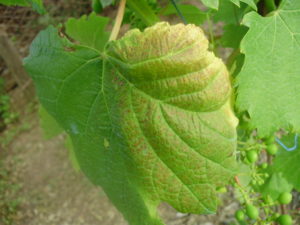
Potassium is one of the main elements of the life of grape plants. Due to it, the ripening of the shoots occurs, the timely ripening of the crop, the sugar accumulation of the fruits. With a lack of this element, the leaves first lose their color, then turn yellow and gradually dry out. Determining the lack of potassium is quite simple - plants that develop normally in spring, with the onset of summer, stop growing, no ovaries are formed, shoots do not grow. If, at the same time, there is not enough potassium and nitrogen, then light green leaves, in early autumn, intensively begin to turn brown and dry. These plants consume a lot of water and can wither in dry summers. In winter, their roots die off. To replenish the trace element, fertilizing with potassium sulfate is used.
Vine leaves can turn pale as a result of fungal infections of the vine. If plants are treated with antifungal drugs in time, then serious consequences can be avoided.
Oidium and mildew can ruin not only the entire berry crop, but the entire vineyard. The occurrence of these diseases can be provoked by warm and humid weather in the winter-spring period.
To prevent the spread of the fungus on the grapes, in the summer, in June, the plants are sprayed with antifungal drugs three times. Processing is carried out in sunny and dry weather, preferably in the evening, the leaves are covered with chemicals on both sides. If it rained and washed off the solution, then the treatment is repeated.
Each year it is worth treating the vine with different preparations, otherwise, fungal organisms may become resistant to them.
Processing is carried out both with purchased products and prepared independently. Wood ash protects well against fungus, which is an ideal source of phosphorus and potassium. Spraying solutions are made from it, and also used as root dressing.
Of the finished products, Fundazol, Radomil, Poliram, Rapid Gold, Kuprikol, Mankozeb, Topaz, Tsikhom and others are used. You can prepare Bordeaux and Californian liquids yourself.
Bordeaux is prepared as follows - copper sulfate powder (100 grams) is mixed with warm water(5 liters). The solution is made immediately before use.
Californian liquid is prepared like this - take water, quicklime and sulfur powder (17: 1: 2). Dough is kneaded from sulfur and water, lime is dissolved in a small amount of water, all components are mixed and boiled for an hour.
If the leaves of your vineyard turn light green, then this is the first sign that something is wrong with the plants. In this case, you should correctly assess the situation, identify the cause, and begin timely treatment. Remember that a healthy vine is a sure guarantee of a rich harvest.